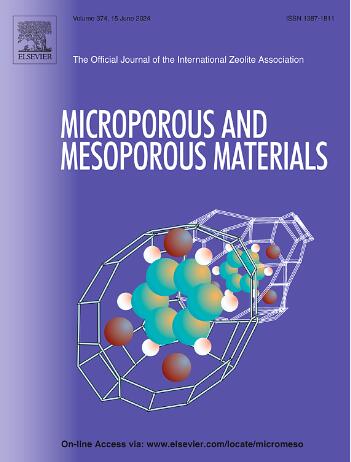Boosting the water absorption of CAU-10: The role of hydrochloric acid in regulating defect concentration
IF 4.8
3区 材料科学
Q1 CHEMISTRY, APPLIED
引用次数: 0
Abstract
CAU-10-H is a promising water adsorbent for adsorption heat transformation systems due to its excellent hydrothermal stability and favorable "S" type isothermal adsorption characteristic. However, its water uptake capacity is relatively low. In this work, the hydrochloric acid modulation defect structure of CAU-10 is rationally developed to get the CAU-10-HCl-2 sample, which possesses high water absorption capacity and outstanding cycle stability. The concentrations of metal atom defects and ligand defects in CAU-10-HCl-2 are 5.8 % and 3.0 %, respectively, which are 29 times and 0.375 times those of the CAU-10 sample without hydrochloric acid addition. This indicates that hydrochloric acid modulation facilitates the production of metal atom defects while suppressing the emergence of ligand defects. The specific surface area, micropore volume, and total pore volume of CAU-10-HCl-2 are 526.6 m2/g, 0.20 ml/g, and 0.23 ml/g, respectively, up 17 %, 25 %, and 10 % from CAU-10. At a relative pressure P/P0 of 0.2, the water uptake of CAU-10-HCl-2 reaches up to 0.29 g/g, which is a 14 % increase compared to CAU-10. Compared to the initial hydration, the water uptake of CAU-10 decreases by 16 % by the 30th cycle, while that of CAU-10-HCl-2 lowers by only 2 %. These results demonstrate that hydrochloric acid modulation is an efficient strategy to improve the water absorption capacity and cyclic stability of CAU-10. This study provides quantitative analysis and synthesis instructions for designing defect structures in CAU-10 via hydrochloric acid modulation.

求助全文
约1分钟内获得全文
求助全文
来源期刊

Microporous and Mesoporous Materials
化学-材料科学:综合
CiteScore
10.70
自引率
5.80%
发文量
649
审稿时长
26 days
期刊介绍:
Microporous and Mesoporous Materials covers novel and significant aspects of porous solids classified as either microporous (pore size up to 2 nm) or mesoporous (pore size 2 to 50 nm). The porosity should have a specific impact on the material properties or application. Typical examples are zeolites and zeolite-like materials, pillared materials, clathrasils and clathrates, carbon molecular sieves, ordered mesoporous materials, organic/inorganic porous hybrid materials, or porous metal oxides. Both natural and synthetic porous materials are within the scope of the journal.
Topics which are particularly of interest include:
All aspects of natural microporous and mesoporous solids
The synthesis of crystalline or amorphous porous materials
The physico-chemical characterization of microporous and mesoporous solids, especially spectroscopic and microscopic
The modification of microporous and mesoporous solids, for example by ion exchange or solid-state reactions
All topics related to diffusion of mobile species in the pores of microporous and mesoporous materials
Adsorption (and other separation techniques) using microporous or mesoporous adsorbents
Catalysis by microporous and mesoporous materials
Host/guest interactions
Theoretical chemistry and modelling of host/guest interactions
All topics related to the application of microporous and mesoporous materials in industrial catalysis, separation technology, environmental protection, electrochemistry, membranes, sensors, optical devices, etc.
 求助内容:
求助内容: 应助结果提醒方式:
应助结果提醒方式:


